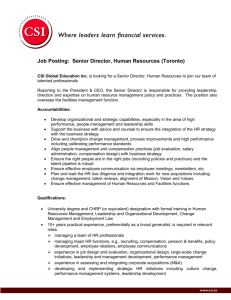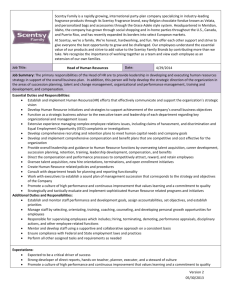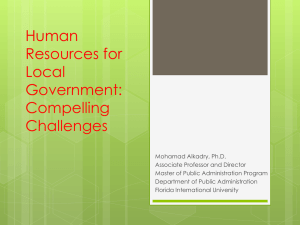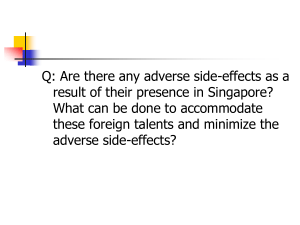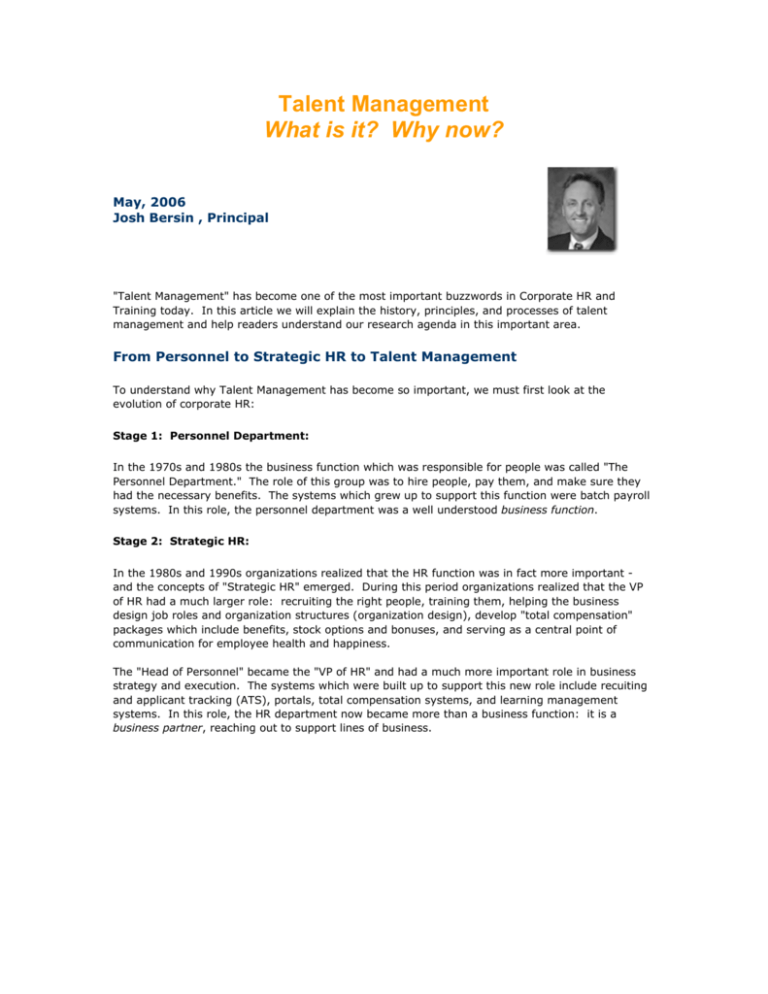
Talent Management
What is it? Why now?
May, 2006
Josh Bersin , Principal
"Talent Management" has become one of the most important buzzwords in Corporate HR and
Training today. In this article we will explain the history, principles, and processes of talent
management and help readers understand our research agenda in this important area.
From Personnel to Strategic HR to Talent Management
To understand why Talent Management has become so important, we must first look at the
evolution of corporate HR:
Stage 1: Personnel Department:
In the 1970s and 1980s the business function which was responsible for people was called "The
Personnel Department." The role of this group was to hire people, pay them, and make sure they
had the necessary benefits. The systems which grew up to support this function were batch payroll
systems. In this role, the personnel department was a well understood business function.
Stage 2: Strategic HR:
In the 1980s and 1990s organizations realized that the HR function was in fact more important and the concepts of "Strategic HR" emerged. During this period organizations realized that the VP
of HR had a much larger role: recruiting the right people, training them, helping the business
design job roles and organization structures (organization design), develop "total compensation"
packages which include benefits, stock options and bonuses, and serving as a central point of
communication for employee health and happiness.
The "Head of Personnel" became the "VP of HR" and had a much more important role in business
strategy and execution. The systems which were built up to support this new role include recuiting
and applicant tracking (ATS), portals, total compensation systems, and learning management
systems. In this role, the HR department now became more than a business function: it is a
business partner, reaching out to support lines of business.
Stage 3:
Talent Management:
We are now entering a new era: the emergence of "Talent Management." While strategic HR
continues to be a major focus, HR and L&D organizations are now focused on a new set of strategic
issues:
How can we make our recruiting process more efficient and effective by using "competencybased" recruiting instead of sorting through resumes, one at a time?
How can we better develop managers and leaders to reinforce culture, instill values, and
create a sustainable "leadership pipeline?"
How do we quickly identify competency gaps so we can deliver training, e-learning, or
development programs to fill these gaps? How can we use these gaps to hire just the right
people?
How do we manage people in a consistent and measurable way so that everyone is aligned,
held accountable, and paid fairly?
How do we identify high performers and successors to key positions throughout the
organization to make sure we have a highly flexible, responsive organization?
How do we provide learning that is relevant, flexible, convenient, and timely?
These new, more challenging problems require new processes and systems. They require tigher
integration between the different HR silos -- and direct integration into line of business management
processes. Today organizations are starting to buy, build, and stitch together performance
management systems, succession planning systems, and competency management systems. The
HR function is becoming integrated with the business in a real-time fashion.
Best-practice examples of companies embarking on these processes
include Aetna, Capgemini, Eastman Chemical, Kimberly-Clark,
PitneyBowes, SCI, Seagate, Steelcase, Textron, and more. You can read
about these companies' talent and performance management initiatives in
Performance Management 2006.
Defining the Talent Management Process
Organizations are made up of people: people creating value through proven business processes,
innovation, customer service, sales, and many other important activities. As an organization strives
to meet its business goals, it must make sure that it has a continuous and integrated process for
recruiting, training, managing, supporting, and compensating these people. The following chart
shows the complete process:
1. Workforce Planning: Integrated with the business plan, this process establishes workforce
plans, hiring plans, compensation budgets, and hiring targets for the year.
2. Recruiting: Through an integrated process of recruiting, assessment, evaluation, and hiring the
business brings people into the organization.
3. Onboarding: The organization must train and enable employees to become productive and
integrated into the company more quickly.
4. Performance Management: by using the business plan, the organization establishes
processes to measure and manage employees. This is a complex process in itself, which we
describe in detail in our new research Performance Management 2006.
5. Training and Performance Support: of course this is a critically important function. Here we
provide learning and development programs to all levels of the organization. As we describe in the
Death of the Corporate University, this function itself is evolving into a continuous support function.
6. Succession Planning: as the organization evolves and changes, there is a continuous need to
move people into new positions. Succession planning, a very important function, enables managers
and individuals to identify the right candidates for a position. This function also must be aligned
with the business plan to understand and meet requirements for key positions 3-5 years out. While
this is often a process reserved for managers and executives, it is more commonly applied across
the organization.
7. Compensation and Benefits: clearly this is an integral part of people management. Here
organizations try to tie the compensation plan directly to performance management so that
compensation, incentives, and benefits align with business goals and business execution.
8. Critical Skills Gap Analysis: this is a process we identify as an important, often overlooked
function in many industries and organizations. While often done on a project basis, it can be
"business-critical." For example, today industries like the Federal Government, Utilities,
Telecommunications, and Energy are facing large populations which are retiring. How do you
identify the roles, individuals, and competencies which are leaving? What should you do to fill these
gaps? We call this "critical talent management" and many organizations are going through this
now.
In the center of this process are important definitions and data: job roles, job descriptions,
competency models, and learning content.
How do you Develop and Implement a Talent Management Strategy?
As I describe above, Talent Management is a natural evolution of HR. It is a series of business
processes -- not a "product" or "solution" you can buy.
Organizations we speak to are focused on different elements -- driven by their maturity and the
urgent business problems they face today. While a few mature organizations have dealt with most
of the processes above, most organizations focus on several of the key elements and build an
integrated approach over time.
Additionally, Talent Management is a "forward-looking" function. Not only should talent
management improve your organization's flexibility and performance, it should give you the
information and tools to plan for growth, change, acquisitions, and critical new product and service
initiatives.
A few critical issues we have identified in our research:
1. Talent Management requires integration and communication between existing HR-L&D
functions.
Training can no longer be "left on an island." As we detail in our workshops, the L&D organization
must align much more closely with the performance management and recruitment
process. Training programs should be developed and updated to continuously address problems
which surface in the performance management process. New hires which are hired because of
certain competencies should see a set of training offerings which complement and reinforce these
competencies. Compensation program should naturally tie to the performance management
process.
2. Competency management, a mis-understood and difficult part of training and HR, has
become critical.
The job descriptions, roles, and competencies used for performance management are shared by
L&D, recruiting, and succession planning. There are many techniques for effective use of
competencies - many are described in our performance management systems research. A simple
best-practice is for your organization to have a small set of consistent, easy-to-understand
competencies which can be applied across the organization.
3. Software solutions are maturing.
Despite vendor claims, there is no complete "talent management" software solution yet. Vendors
each offer different elements of this solution. To solve urgent problems, most companies today buy
standalone systems: standalone learning management systems, standalone standalone
performance management systems, standalone recruiting and standalone compensation systems.
As the market matures and companies press harder for integration, vendors will create more
integrated solutions.
Even if you do find an integrated toolset which manages multiple talent processes, the biggest
challenges in implementation are integrating you own business processes. Our keynote new
research report, Performance Management 2006, details the state of this industry and provides
detailed analysis of the top 20 performance and talent management systems providers.
What does this mean to your Organization?
Talent Management is a powerful and important trend across HR and L&D. It changes the way you
are organized, how you use technology, how your resources are allocated, and how you measure
what you do. If you are a training manager, director, or CLO, talent management will impact your
role. You may be asked to integrate your learning programs with the company's performance
management initiative.
Many organizations have a new job: The VP of Talent Management. This role typically includes
Learning & Development, Performance and Competency Management, and Succession Planning
fucntions. We believe that this integrated "HRD" function is an important evolution in the way HR
organizations are run.
What does this mean to your HR-IT Strategy?
Talent Management will also impact your systems strategy: For example, do you want a standalone LMS or should your LMS be integrated with the company's performance management
systems? What systems integration are the most important? How do you use competency models
to tie learning to performance management? What "suite" products are mature enough for your
particular organization's needs?
The role of HRIT has also become much more complex. It is no longer possible to focus on HRIS
systems alone - HRIT must understand learning technology, competency management technology,
portal technology, and the integration of these different applications. In many organizations LMS
systems, for example, are not managed by HRIT. Over time we believe the role of HRIT will be
more strategic than ever.
How can you learn more?
One of the best ways to learn more about this important area is to read our keynote new research
report: Performance Management 2006. This report, the culmination of almost 18 months of
research in this area, will help you understand best practices, trends, and vendor solutions in
performance and talent management and give you valuable insights on processes, systems and
strategies.
We are actively involved in vendor research, best-practices research, and case studies. If you have
questions or a best-practice case study to share, please contact us.
Key Research to Help you Understand This Area
Performance Management 2006 Industry Study
The High Impact Learning Organization Research
The Convergence of Learning and
Performance Management
High Impact Learning Organization Workshop
Confronting the Leadership Crisis:
What Works, What Doesn’t, What Lies Ahead
Highlights and Insights from Hay Group and Chief Executive
magazine Research into "The Best Companies for Leaders"
© 2006 Hay Acquisition Company I, Inc. All Rights Reserved.
2
Agenda
The Leadership Crisis
Hay Group/CEO Magazine “Best Companies for Leaders”
research findings:
– What works
– What helps
– What’s not worth the effort
What you can do about it
Presenters
– Mary Fontaine
– Tharuma Rajah
– Bruce Sevy
© 2006 Hay Acquisition Company I, Inc. All Rights Reserved
3
The global leadership crisis
Some economists are calling this an “economic tsunami”
Organizations around the globe are struggling to develop the
number and quality of leaders they need to survive and thrive
– In the US and Europe it is a crisis of replacing retiring leaders
– In India and Asia it is a crisis of keeping pace with growth
Globally, the limiting factor for continued organizational
success will be access to a sufficient number of high-quality
leaders
© 2006 Hay Acquisition Company I, Inc. All Rights Reserved
4
Are you prepared?
What’s keeping today’s CEO awake?
– Identifying potential leaders
– Getting them into the pipeline
– Getting leaders developed as quickly and effectively as possible
The Hay Group / CEO Magazine research provides the critical
insights you need to chart a path forward
© 2006 Hay Acquisition Company I, Inc. All Rights Reserved
5
Hay Group/CEO Magazine Research
In 2005, Hay Group and CEO Magazine partnered on a study
looking at leadership development in 300+ global and regional
companies
We focused on:
– Satisfaction with the number and quality of leaders
– Philosophies, programs and practices used to develop leaders
We collected data from four sources
–
–
–
–
Surveys completed by senior line managers and HR leaders
Industry peer ratings
Insights from leading academicians
Ratings from executive search firms
Here’s what we found…
© 2006 Hay Acquisition Company I, Inc. All Rights Reserved
6
The Global Best Companies for Leaders
1.
2.
3.
4.
5.
6.
7.
8.
9.
10.
Procter & Gamble
PepsiCo.
IBM
General Electric
Johnson & Johnson
Dell
Microsoft
Home Depot
JP Morgan Chase
Motorola
© 2006 Hay Acquisition Company I, Inc. All Rights Reserved
11.
12.
13.
14.
15.
16.
17.
18.
19.
20.
Pfizer
FedEx
BASF
Verizon
BAE Systems
Johnson Controls
Siemens
BP
L’Oréal
Colgate-Palmolive
7
The Global Best report having more & better leaders
20 Best
Company’s report on number
and quality of leaders
High
All Others
The global best report:
– more leaders
– better leaders
For all organizations,
having enough leaders is
the critical issue
Low
Quality
of Leaders
Number
of Leaders
© 2006 Hay Acquisition Company I, Inc. All Rights Reserved
8
Having strong leaders pays
5-Year Annualized Return on Share Price
2.62%
20 Best
S&P 500
-2.68%
© 2006 Hay Acquisition Company I, Inc. All Rights Reserved
9
Key findings
The best companies for leaders invest heavily in leadership
development and do more of “everything”
Not everything makes a difference, but there are a vital few
things that do
In combination, six things account for most of the difference in
number and quality of leaders
Just developing individual leaders won’t get you there
What differentiates the best is that they work at three levels:
– Organization
– Team
– Individual
© 2006 Hay Acquisition Company I, Inc. All Rights Reserved
10
Contribution to number and quality of leaders
Contribution to number
and quality of leaders
High
The vital six
Low
Everything else
© 2006 Hay Acquisition Company I, Inc. All Rights Reserved
The vital six account for 2/3rds
of the differences in number
and quality of leaders
Contribution is the same for
the best small companies as
for the global best
11
The vital few that really matter
Best Global Companies for Leadership focus on the “Big Six”
1. CEO and senior leaders make leadership
development a top priority.
2. Leaders at all levels are accountable for creating a work
climate that motivates employees to perform at their best.
3. Leadership teams receive training and coaching to help them
work together more effectively.
4. Mid-career managers receive job-shadowing opportunities.
5. High-potentials receive objective 360-degree assessments
and feedback on their leadership ability early on.
6. Mid-level managers get enough time to take part in
leadership development activities early in their careers.
© 2006 Hay Acquisition Company I, Inc. All Rights Reserved
12
If you have the resources, do these next
External MBA programs
External coaches for senior executives
Internal coaches for mid-level managers
Specific skill building for lower-level managers
Externally run development programs
Job rotations
© 2006 Hay Acquisition Company I, Inc. All Rights Reserved
13
What to cut?
Some practices make little or no contribution to the
number and quality of leaders
Paper-based self-study leadership modules for mid- and
senior-level managers.
Outdoor activity-based programs for mid- and senior-level
managers.
Internally run classroom-based leadership training programs
for mid-level managers.
Using internal coaches to coach senior executives.
Using external coaches to coach mid-level managers.
© 2006 Hay Acquisition Company I, Inc. All Rights Reserved
14
What you can do
1. Make sure you and your senior executives are personally
involved in leadership development and creating a culture of
leadership
2. Hold leaders throughout the organization accountable for
creating high performance work climates
3. Provide development for leadership teams and not just for
individual leaders
4. Use objective assessment and feedback to focus
development in the areas that make the biggest difference
5. Start early, make time and ground leadership development in
the real world
© 2006 Hay Acquisition Company I, Inc. All Rights Reserved
15
Thank you for participating
More information
For more information on “The Best Companies for Leaders,”
visit http://www.haygroup.com/Chief_Executive/
Questions or comments?
Send an email with questions or comments to:
Leadership_Development@haygroup.com
Be a part of the 2006 study
In a few months we will begin to research the
2006 Best Companies for Leaders. Watch for an
email from Hay Group with details on how to participate.
© 2006 Hay Acquisition Company I, Inc. All Rights Reserved
The Talent Show – Ten Steps to
an Effective Succession Plan
Presented by:
Mary-Jane Sinclair, SPHR
President
Sinclair Consulting, Inc.
Morristown, NJ 07960
973-267-0169
Why Do People Leave?
Q
Q
Q
Q
Q
Q
Better opportunities
Too difficult to work here
Never did fit in here
Can’t get ahead
Poor management
Can’t seem to do anything right
What Can You Do?
Q
Q
Q
Q
Budget more for recruiting
Lower your job standards
Change the environment
Plan for turnover
Succession Planning Is The
Answer
Q
Q
Better definition:
Talent
Identification and Development Plan
Often includes both replacement
planning and succession planning
Top Ten Reasons To Have A
Plan
Q
Q
Q
Q
Q
Q
Q
Q
Q
Q
More opportunities for high potentials
A road map for employee development
More talent ready sooner
More support for diverse workforce
Better morale
Lower turnover
Lower stress
Job content tied to business plan
Smoother disaster recovery
More focus on vision and direction
Things to Consider
Q
Q
Q
Q
Q
Q
Who will decide?
How much time will you spend?
How will you prepare?
What positions will it cover?
Who will get involved?
Who do you tell? What do you tell
them?
Things To Plan For
Q
Q
Q
Q
Q
Q
Technology
Globalization
Cost containment
Speed of market change
Importance of knowledge capital
Increasing rate and level of change
Rothwell. William J. Effective Succession Planning, 2nd ed. New York,
AMACOM, 2001
Trends Influencing TID&D Plans
Q
Q
Q
Q
Q
The need for speed
A seller’s market for skills
Reduced loyalty
Importance of intellectual capital and
knowledge management
Key importance of values and
competencies
Rothwell. William J. Effective Succession Planning, 2nd ed. New York,
AMACOM 2001
Defining Effective Programs
Q
Q
Q
Q
Q
Specific
Broad
Supported and supportive
Systematic
Focus on development
Possible Glitches
Q
Q
Q
Q
Q
Q
Politics get in the way
Not enough support
Focus on today
Can’t keep pace
Just more red-tape
Communication or lack thereof
Steps in a Program
Q
Q
Q
Q
Q
Q
Q
Q
Q
Q
Q
Get management commitment
Review company business plan
Establish a systematic program
Identify covered positions
Develop talent needs for covered positions
Profile employees
Match employees to needs
Identify gaps/potentials
Set development goals
Implement development program
Measure progress and make adjustments
Step One:
Get Management Commitment
Q
Q
Q
Q
Q
Q
Q
What are current problems? (turnover,
etc.)
How do we currently address them?
What do other companies do?
How could we fix problems?
Who will be involved?
How often will we meet?
What policies will we put in place?
Step Two:
Review Company Business Plan
Q
Q
Q
Identify company direction
Tie talent needs to company direction
Looks at current and future needs
Step Three:
Establish A Systematic Program
Q
Q
Q
Q
Q
Q
Clarify roles
Prepare policies and procedures
Set up recordkeeping system
Identify target groups
Conduct legal review of program
Address communications strategies
Step Four:
Identify Covered Positions
Q
Q
Q
What levels will your plan cover?
Will there be more than one talent pool?
How many backups will you need to
account for:
– turnover
– poor performance
– poor matches
Step Five:
Develop Talent Needs
Q
Q
Q
Q
Q
Analyze jobs and tasks
Review or prepare position descriptions
Develop competency list
Identify work values for position
Look at current and future needs
Step Six:
Profile Employees
Q
Q
Look at performance record
Consider
– level of performance
– breadth of expertise
– learning agility
– skills acquisition
Step Seven:
Match Employees to Needs
Q
Q
Q
Q
High-pots
Steadies
Iffies
Nots
Step Eight:
Identify Gaps/Potentials
Q
For those ready now:
– what will be done?
Q
For those not ready now:
– Can they be developed?
– Should they be developed?
– How can they be developed?
– How long would it take?
Q
For those never ready:
– what will happen to them?
Step Nine:
Set Development Goals
Q
Q
Q
Q
Q
Establish likely activities
Set timeframe
Determine resource needs
Set measurements
Agree on action
Step Ten:
Implement Development
Program
Q
Q
Q
Q
Clarify manager’s role
Establish mentoring program
Assign a “Career Coach”
Considerations in agreeing on # of
actions to take
“Bonus”Step:
Measure Progress and Adjust
Q
Q
Q
Q
Set schedule for feedback
Periodically review progress
Mental agility
Adjust activities as needed - add or take
away based on progress
Lombardo, Michael M. and Eichinger, Robert W. The Leadership Machine.
Minneapolis, MN, Lominger Limited, Inc., 2001
What Else Should We Do?
Q
Q
Q
Q
Build recruiting around organization
needs
Use job profiles in recruiting
Review need for key jobs periodically
Move program as organization moves!

